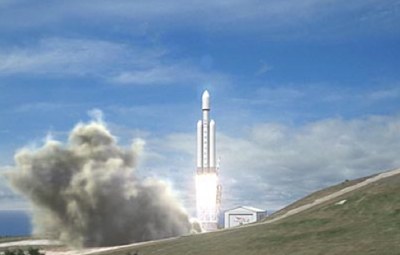A new rocket for scienceby S. Alan Stern
|
| It doesn’t take a rocket scientist to understand that broad use of the Falcon Heavy by NASA’s Science Mission Directorate could translate to large and much-needed cost savings. |
Among the most important benefits offered by this new rocket, with a fairing five meters in diameter and lift capability to low Earth orbit (LEO) of 53,000 kilograms, is that it is priced at approximately $100 million—not far from the old price of the Delta 2 workhorse launcher for NASA science missions over the past two decades. But despite the similar price, the Falcon Heavy will be able to lift nine times what a Delta 2 can to LEO. Moreover, its capacity is almost twice that of NASA’s current heavy lifter for science, the largest Atlas 5, but at half to one-third the cost.
The lift performance of the Falcon Heavy opens up some entirely new opportunities for science, such as fielding planetary sample returns in a single bound, emplacing a multi-node lunar geophysical network, co-manifesting multiple large spacecraft on a single launcher, and relaxing mass constraints and therefore revolutionizing the electrical power available to future research spacecraft.
And with the vehicle’s combination of dramatically higher performance and dramatically lower costs, it doesn’t take a rocket scientist to understand that broad use of the Falcon Heavy by NASA’s Science Mission Directorate (SMD) could translate to large and much-needed cost savings.
Consider this: the typical rate of SMD launches over the past decade is three to five per year. If we adopt a figure of merit savings over current Evolved Expendable Launch Vehicles (EELVs) of just $100 million per launch—a very conservative figure given the recent upward trajectory of EELV launch costs—then over a five-year period the Falcon Heavy dividend could amount to $1.5–2.5 billion in savings for SMD. That’s enough to build and launch four to ten additional planetary Discovery missions, astrophysics/heliophysics Explorers, or Earth science missions over a decade.
Importantly, however, the benefits that the Falcon Heavy offers to science don’t stop with the potential for steep launch cost savings. The rocket offers so much lift capacity relative to its competitors that it also will be able to enable co-manifesting of science missions with commercial satellites and remove the tight launch mass constraints on science satellites and planetary probes that often drive development costs. These opportunities can further extend the Falcon Heavy’s projected cost savings and help resuscitate beleaguered Earth and space science disciplines.
And given the tough outlook for SMD (and indeed all of NASA’s) budget in the coming cost-constrained years, combined with the upward pressure of science missions suffering cost overrun, the Falcon Heavy looks like rare and much-welcomed relief, a strongly positive indicator in a world filled with too many foreboding challenges to science at NASA.
| A sensible but accelerated approach by NASA to bringing the Falcon Heavy through the launch certification process and into its catalog of launchers seems like sound policy. |
That said, the promise offered by the introduction of the Falcon Heavy cannot be realized until NASA places this vehicle in its permitted science mission launcher catalog. As such, one hopes that the agency will reduce the flight experience metrics needed to get the rocket into the science mission launch queue as soon as possible. This might entail taking a little more risk than is sometimes desired, but in my view this risk is greatly outweighed by the potential to enable so many additional science missions to come to fruition from the accrued cost savings.
Given the urgency of the times, the many pressing needs of NASA’s science mission disciplines, and the current climate’s increased taxpayer scrutiny, a sensible but accelerated approach by NASA to bringing the Falcon Heavy through the launch certification process and into its catalog of launchers seems like sound policy.
Scientists and science advisory committees have a role to play here alongside the agency, by making recommendations along these same lines, so that the cost relief that the Falcon Heavy offers can create a healthier science mission launch manifest sooner rather than later.
